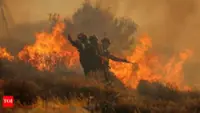A douglas fir grows in the eco-camp in Hasselfelde, a real-life open-air laboratory or experimental forest that seeks to work out how different tree species develop and thrive in changing climate conditions. Photo: Matthias Bein/dpa
With its lush greenery, fresh breezes and chirpy birdsong, to Werner Gutbier, it feels like paradise when he enters the eco-camp he planted decades ago.
A forester by profession, Gutbier planted his eco-camp on what was a meadow when he started working nearby, eager to see a greater diversity of tree species.





